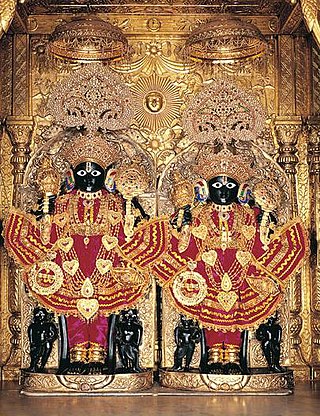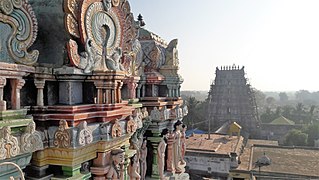Related Research Articles

Shesha, also known by his epithets Sheshanaga and Adishesha, is a serpentine demigod (naga) and Nagaraja, as well as a primordial being of creation in Hinduism. In the Puranas, Shesha is said to hold all the planets of the universe on his hoods and to constantly sing the glories of Vishnu from all his mouths. He is sometimes referred to as Ananta Shesha, "Endless-Shesha", or Adishesha, the "First Shesha". It is said that when Shesha uncoils, time moves forward and creation takes place; when he coils back, the universe ceases to exist.

Narayana is one of the forms and epithets of Vishnu. In this form, the deity is depicted in yogic slumber under the celestial waters, symbolising the masculine principle and associated with his role of creation. He is also known as Purushottama, and is considered the Supreme Being in Vaishnavism.
Bargarh is an emerging city and municipality in Bargarh district in the state of odisha in India. It is the administrative headquarters of Bargarh District. Bargarh is popularly known for intensive cultivation of 'paddy', therefore called "Bhata Handi" of Odisha.

Naranarayana, also rendered Nara-Narayana, is a Hindu duo of sage-brothers. Generally regarded to be the partial-incarnation (aṃśa-avatara) of the preserver deity, Vishnu, on earth, Nara-Narayana are described to be the sons of Dharma and Ahimsa.

Lakshmi Narayana or Lakshmi Narayan is the dual representation of the Hindu deities Vishnu, also known as Narayana, and his consort, Lakshmi, traditionally featured in their abode, Vaikuntha. The goddess of prosperity and beauty, Lakshmi, is depicted as standing next to Vishnu, who holds the Panchajanya, Kaumodaki, Padma, and the Sudarshana Chakra. Another depiction of Lakshmi-Narayana portrays Lakshmi in the service of Narayana, who reclines on the cosmic serpent Shesha, floating in the Kshira Sagara, the Ocean of Milk.

Ananta Vasudeva Temple is a Hindu temple dedicated to Krishna, an avatar of Vishnu located in Bhubaneswar, the state capital of Odisha, India. The temple was constructed in the thirteenth century, and the complete murtis of Krishna, Balarama and Subhadra are worshipped there. The temple dates back to the period of Chandrika Devi, the daughter of Anangabhima III, during the reign of the king Bhanudeva. A commemorative inscription that marked the foundation of the temple can be found in the British Museum's collection.

Anangabhima Deva III was an Eastern Ganga monarch who ruled an early medieval Odisha centered empire in eastern India from the year 1211 CE to 1238 CE. He was successful in maintaining a large extent of territory that stretched from the river Ganga in the north to Godavari in the South. He had successfully defeated the Kalachuris on the western frontiers of the empire and established a matrimonial alliance with them. His brother or brother in law, Rajaraja II became the ruler of the Dynasty in 1198. When Anangabhima III came into power, in 1211, he expelled the Muslims of Bengal from his kingdom. He had a son, Narasingha Deva I, who would later invade Bengal in 1244, and captured the capital city, Gauda. He was a reformist in the social and spiritual structure of the Odia society as the vaishnavite deity Jagannath was declared as the supreme ruler of the empire and the emperor as the deputy under him. The Madala Panji records he claiming himself as Shri Purushottama dedicating everything to lord Jagannath. He built the famous Pradaskhina mandapa of Srikurmam temple.

The Ranganathaswamy temple or Sri Ranganathaswamy temple in Srirangapatna, in the Mandya district of Karnataka state, India, is dedicated to the Hindu god Ranganatha. The temple is Classified one among the 108 Abhimana Kshethram of Vaishnavate tradition. It is one of the five important pilgrimage sites of Sri Vaishnavism along the river Kaveri for devotees of Ranganatha. These five sites are collectively known as Pancharanga Kshetrams in South India. Since Srirangapatna is the first temple starting from upstream, the deity is known as Adi Ranga. The town of Srirangapatna, which derives its name from the temple, is located on an island in the river Kaveri.

Padmanabham mandal is one of the 46 mandals in Visakhapatnam District in India. It is under the administration of Bhemunipatnam revenue division and the headquarters is located at Padmanabham. The Mandal is bounded by Bheemunipatnam, Anandapuram mandals in Visakhapatnam District and Bhogapuram mandal in Vizianagaram District. Great freedom fighter Alluri Sitarama Raju was born in Pandrangi village in this Mandal.Rajasagi Suryanarayana Raju, MLA Bheemili from 1972–78 is from this Mandal. Also Rajasagi Appalanarasimha Raju MLA Bheemili from 1985 to 2004 is also from this Mandal.

The Vilwadrinatha Temple is a Hindu temple in Thiruvilwamala, a town in the city of Thrissur, Kerala, India. The principal deities are Rama, the seventh incarnation of the god Vishnu, and his brother, Lakshmana. This is one of the four major Rama temples in Kerala—the other three are in Thriprayar, Kadavallur, and Thiruvangad. The temple houses an idol of Lakshmana, which is rare in India.

Sapta Badri constitutes a group of seven sacred Hindu temples, dedicated to god Vishnu, located in Garhwal Himalayas in the Indian state of Uttarakhand. The Badrinath temple, called the Badri Vishal is the primary temple among the seven shrines. The other six being Adi Badri, Bhavishya Badri, Yogadhayan Badri, Vriddha Badri, Ardha Badri and Dhyan Badri. The Panch Badri temple circuit consisted of only five temples, omitting Ardha Badri and usually Dhyan Badri. Rarely, Narasingh Badri, is included in the Sapta Badri or Panch Badri list.
Shitalasasthi also known as Sital sasthi is celebrated as the wedding of Shiva and Parvati, a major festival of Utkal Brahmins and Aranyaka Brahmins since ages. It was started 400 years ago in Sambalpur after the king of Sambalpur brought Utkal Srotriya Vaidika Brahmins from brahmin sasana villages of Puri district. The localities of Nandapada are the oldest of these Brahmins. They first started Sitalsasti Utsav. This Hindu festival is in the form of a carnival where people and artists from different walks of life participate making it more beautiful and bringing out the true colours of life. Every year it is celebrated towards the end of the summer season, the aim being to call the rain Gods to give reprieve from the scorching heat of the Sun. During the carnival period, Sambalpur attracts tourists from nearby states and abroad also.
Narayan Gosain Temple is a Hindu temple situated at Singhapur Village in Jajpur district of Odisha, India which is dedicated to the god Vishnu.

Madhava Temple,, is the temple dedicated to Lord Vishnu. It is located at the Madhab village of Niali block in Cuttack district, Odisha.

Anantashayi Vishnu, also known as Anantashayana Vishnu, is a large open air horizontal rock relief of the Hindu god Vishnu, carved during the early 9th century in Saranga village, under the Parjang police station, in the Dhenkanal district of Orissa, India. It is located on the left bank of the Brahmani River. It is the largest such exposed rock cut structure in the horizontal position measuring 15.4 metres (51 ft) in length, in the whole of India, while the largest standing image is of Gomateshwara in Southern India. It is a protected monument maintained by the Archaeological Survey of India, Bhubaneswar Circle. Worship is still offered to the four armed reclining Vishnu.

Thirumanimadam or Narayanan Perumal Temple is dedicated to Hindu god Vishnu located in Thirunangur, a village in the outskirts of Sirkazhi in the South Indian state of Tamil Nadu. Constructed in the Dravidian style of architecture, the temple is glorified in the Nalayira Divya Prabandham, the early medieval Tamil canon of the Alvar saints from the 6th–9th centuries CE. It is one of the 108 Divya Desams dedicated to Vishnu, who is worshipped as Narayanan and his consort Lakshmi as Pundarikavalli.

Ninra Narayana Perumal Temple or Thiruthankaal in Thiruthangal, a town in the outskirts of Sivakasi in the South Indian state of Tamil Nadu, is dedicated to the Hindu god Vishnu. Constructed in the Dravidian style of architecture, the temple is glorified in the Divya Prabandha, the early medieval Tamil canon of the Alvar saints from the 6th–9th centuries AD. It is one of the 108 Divya Desam dedicated to Vishnu, who is worshipped as Ninra Narayana and his consort Lakshmi as Arunakamala Mahadevi.

Sowmyanarayana Perumal Temple is an ancient temple located in Thirukoshtiyur, a village in the South Indian state of Tamil Nadu, dedicated to the Hindu god Vishnu. Constructed in the Dravidian style of architecture, the temple is glorified in the Nalayira Divya Prabandham, the early medieval Tamil canon of the Alvar saints from the 6th–9th centuries CE. It is one of the 108 Divya Desams dedicated to Vishnu, who is worshipped as Sowmyanarayana Perumal and his consort Lakshmi as Thirumamagal. The temple is known as the place where Ramanuja, the expounder of Vishishtadvaita philosophy preached the holy ashtakshara "Om Namo Narayanaya" to all people, irrespective of their varna.

The Narasimhaswamy temple in Namakkal, a town in Namakkal district in the South Indian state of Tamil Nadu, is dedicated to the Hindu god Narasimha, an avatar of Vishnu. Constructed in the Dravidian style of architecture and Rock-cut architecture, the temple is located in the Salem–Namakkal–Trichy Road. The legend of the temple is associated with Narasimha, an avatar of Hindu god Vishnu appearing for Lakshmi, his consort, and Hanuman. Based on the architectural features, historians believe that the temple was built during the 8th century by the Adiyamans also called Satyaputras as evident from the inscription mentioning the temple as 'Adiyendra Vishnu Gruham' or 'The house of Vishnu of the Adiyaman kings'. The temple does not find a mention in Nalayira Divya Prabhandams, and thus is not listed in Divya Desam group of 108 temples. But it is classified one among the 108 Abhimana Kshethram of Vaishnavate tradition.
References
21°28′17″N83°57′45″E / 21.471392°N 83.962501°E